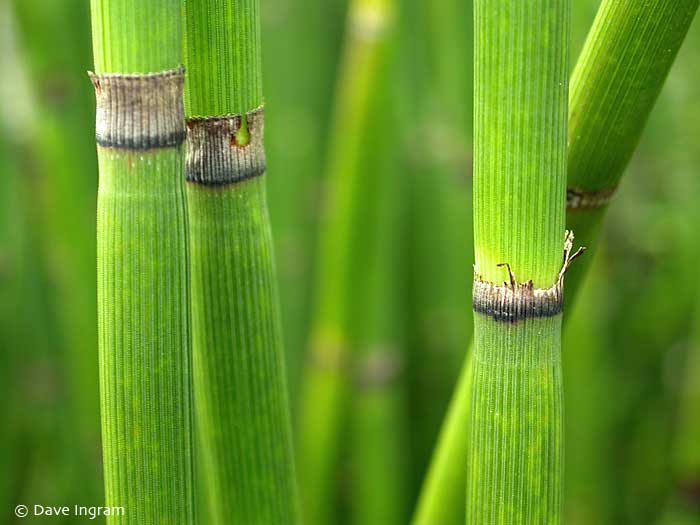During a recent visit to Sayward I happened upon a patch of giant horsetails rising from a roadside ditch. Strangely alluring, the pale brown wand-like fertile shoots appear in spring, followed shortly after by green, vegetative shoots. These anemic fertile shoots, which only last for a short period, are easily overlooked. Most of us are more familiar with the green vegetative shoots, which persist for much longer.
Distinctive Features of Horsetails
Horsetails have hollow, grooved stems with regular joints. Silica on the outer surface of the stem gives it a rough texture, rather like the surface of a nail file. A brownish sheath at each joint is rimmed by darker teeth, which are in fact the tiny leaves of the plant. Whorls of green “branches” fan out from between the joints. Horsetails have perennial underground horizontal stems (rhizomes), from which the shoots arise. For this reason they are often found in groups.
Most species of horsetails prefer a wet location, and are often found in ditches, swamps, and banks of creeks and rivers. Common horsetail, however, is quite versatile and may spring up weed-like in abandoned fields, backyards, and sandy areas.
Though the green parts of horsetail can be toxic to livestock and humans, some First Nations peoples of the Pacific Northwest ate them in moderation as a spring vegetable. They were also used for polishing wood. Pioneers made use of the coarse surface of horsetails to scour out dirty pots. This is how one type of horsetail, the scouring-rush, got its name.
Ancient Plants From the Time of Dinosaurs
Horsetails are very ancient plants, and have been around for at least 300 million years. During the late Devonian and Carboniferous periods, low-lying tropical swamps and shallow seas covered much of Europe and North America. One of the most common swamp plants were large horsetail trees called Calamites, which grew to 18 metres in height, with trunks up to half a metre wide.
In the late Paleozoic period, droughts are thought to have caused the demise of this wonderfully weird tree. But smaller relatives of the Calamites survived, and the horsetails of today are remarkably similar to those of ancient times.
How Horsetails Reproduce
Horsetails are a unique group of plants. In the evolutionary scheme of things they are placed between simple, primitive plants like mosses, and more highly evolved flowering seed plants. Like mosses and ferns, horsetails produce spores. Like flowering seed plants, they have specialized tissues for conducting water and food through the stem. Plants with these tissues are generally called “vascular” plants.
Horsetail reproduction begins with a cone-like “strobilus” at the top of the plant. The cone is made up of rows of hexagonal spore-bearing structures. Each hexagon produces thousands of tiny spores. When the spores are shed, they start to grow into a new plant, which is either bisexual or male. Sperm are produced, which must swim through the water to female plants. Once fertilized, the plant will grow to maturity, starting the cycle over again.
There are only about twenty species of horsetail in the world, all in one group, or genus, known as Equisetum. Ten species are found in BC, and six of these exist on Vancouver Island.
Common Species of Horsetails in British Columbia
Two frequently found species, giant horsetail (Equisetum telmatiea) and common horsetail (Equisetum arvense), produce both pale brown fertile shoots and vegetative green shoots that are connected by an underground stem. The giant horsetail is larger than the common horsetail, with thicker stems. The green stems of both species have whorls of green branches. These vegetative shoots transform solar energy into food through the process of photosynthesis.
Another commonly encountered species is the bluish-green scouring-rush (Equisetum hyemale). Scouring-rushes have straight stems without branches. Fertile shoots are not separate, and cones are found at the tips of the green stems.
Horsetails are ancient and beautiful plants. To see the fertile shoots of horsetails rising from the ditches, one is reminded of the profound history of this plant. Having been around for 300 million years, horsetails vastly predate any human presence on the planet, challenging our limited conception of time.
About the Contributor:
Jocie Brooks is a naturalist and writer based in the Comox Valley, Vancouver Island, British Columbia.



